Apr 1, 2012
Why diet experts are worried about Indians and junk food
Diet experts have said Indians are consuming junk foods more often than in the past, and have warned that this poses a major risk to their health.
Deputy Programme Manager at the Food Standards and Safety Authority of India (FSSAI) Savvy Soumya Mishra said that merely criticising international fast food chains for spoiling Indian dietary patterns is not enough.
She said that fast food had reached rural markets in the form of potato chips and soft-drinks and wished remedial measures are taken.
"Potato chips and similar snacks are available even in remote villages, where you may not find a school or a ration shop. These things have more reach. There will be soft-drink bottles in places that may not have even clean drinking water. McDonald's and Pizza Hut may not have reached there, but chips and soft drinks have, what a pity!" Mishra said.
She further stressed on the importance of reducing children's access to trans fat-laden junk food, suggesting a ban on such eatables in schools.
"Imposing a ban is the government's decision, but junk food must be banned in schools because it is difficult to restrain children. You can ban it in school and introduce fruits and fruit juices. There are also many things prepared at home. We grew up eating a lot of other things, traditional food. We did not grow on chips and packaged snacks like Kurkure," added Mishra.
Delhi-based cardiologist Dr KK Aggarwal, said the problem of junk food was not just limited to food items like burgers and pizzas.
He said traditional Indian snacks prepared using vegetable fat were also a big threat.
"We shouldn't get carried away and just ban burgers. Everything that just tastes good is bad for health, because such things will either be made with 'ghee' (clarified butter), which is very unlikely, or with trans fats sourced from vegetables. So, whatever contains trans fats is unhealthy, regardless of whether it is commercial or not," observed Dr Aggarwal.
However, the commoners' reaction towards junk seemed to be mixed.
"Young people these days prefer fast food. But as the report has said, one should avoid that food. As far as traditional recipes are concerned, we should go for that," said Suresh, a resident of the city.
The contrary opinion suggested that junk food was a necessity given the changed nature of people's daily lives, and now came in many variants, some of them healthier than the rest.
"These days, people need their food quick. Many families have both parents working, so burgers and chips are very good alternatives for those who are in a rush. But these things come in many varieties. Now we have potato chips, which are baked. One can eat well, it is also a little costly, but we can't say these things are useless," said Arpit, another resident.
The FSSAI pronounces products free of trans fats if they have less than 0.2 grams of trans fats per serving.
A recent report by the Centre for Science and Environment had accused many brands of labelling their products transfat-free even though they contained it in large amounts.
Trans fat consumption increases the risk of coronary heart disease, leading to recommendations by health experts that they be consumed only in traces.
Deputy Programme Manager at the Food Standards and Safety Authority of India (FSSAI) Savvy Soumya Mishra said that merely criticising international fast food chains for spoiling Indian dietary patterns is not enough.
She said that fast food had reached rural markets in the form of potato chips and soft-drinks and wished remedial measures are taken.
"Potato chips and similar snacks are available even in remote villages, where you may not find a school or a ration shop. These things have more reach. There will be soft-drink bottles in places that may not have even clean drinking water. McDonald's and Pizza Hut may not have reached there, but chips and soft drinks have, what a pity!" Mishra said.
She further stressed on the importance of reducing children's access to trans fat-laden junk food, suggesting a ban on such eatables in schools.
"Imposing a ban is the government's decision, but junk food must be banned in schools because it is difficult to restrain children. You can ban it in school and introduce fruits and fruit juices. There are also many things prepared at home. We grew up eating a lot of other things, traditional food. We did not grow on chips and packaged snacks like Kurkure," added Mishra.
Delhi-based cardiologist Dr KK Aggarwal, said the problem of junk food was not just limited to food items like burgers and pizzas.
He said traditional Indian snacks prepared using vegetable fat were also a big threat.
"We shouldn't get carried away and just ban burgers. Everything that just tastes good is bad for health, because such things will either be made with 'ghee' (clarified butter), which is very unlikely, or with trans fats sourced from vegetables. So, whatever contains trans fats is unhealthy, regardless of whether it is commercial or not," observed Dr Aggarwal.
However, the commoners' reaction towards junk seemed to be mixed.
"Young people these days prefer fast food. But as the report has said, one should avoid that food. As far as traditional recipes are concerned, we should go for that," said Suresh, a resident of the city.
The contrary opinion suggested that junk food was a necessity given the changed nature of people's daily lives, and now came in many variants, some of them healthier than the rest.
"These days, people need their food quick. Many families have both parents working, so burgers and chips are very good alternatives for those who are in a rush. But these things come in many varieties. Now we have potato chips, which are baked. One can eat well, it is also a little costly, but we can't say these things are useless," said Arpit, another resident.
The FSSAI pronounces products free of trans fats if they have less than 0.2 grams of trans fats per serving.
A recent report by the Centre for Science and Environment had accused many brands of labelling their products transfat-free even though they contained it in large amounts.
Trans fat consumption increases the risk of coronary heart disease, leading to recommendations by health experts that they be consumed only in traces.
Health Benefits of Organic Cereals
 Cereals have constituted an integral part of the human diet since the dawn of civilization. The cultivation of cereals played an influential role in history as it helped shape the primitive societies of Egypt and the far East. Even today, cereals are widely consumed throughout the world. Wheat is one of the most popular cereals that is grown and consumed all over Europe and India. Maize is the staple cereal of both Central America and Africa, while rice is most popular in countries such as Japan, India and China. Cereals in the form of rice are widely consumed in these countries as they are a cheap source of carbohydrates.
Cereals have constituted an integral part of the human diet since the dawn of civilization. The cultivation of cereals played an influential role in history as it helped shape the primitive societies of Egypt and the far East. Even today, cereals are widely consumed throughout the world. Wheat is one of the most popular cereals that is grown and consumed all over Europe and India. Maize is the staple cereal of both Central America and Africa, while rice is most popular in countries such as Japan, India and China. Cereals in the form of rice are widely consumed in these countries as they are a cheap source of carbohydrates.It is estimated that cereals provide as much as 70 to 80% of the daily energy requirement of people in Asia. Packed with proteins, starch, fats, vitamins, salt and essential minerals, cereals are the ultimate health food as they offer a plethora of health benefits. The high fiber content of cereals acts as mucilage and facilitates healthy bowel movements. A diet rich in cereals has also been found to prevent heart diseases and lower cholesterol in the body. In this article, we shall take a closer look at some key health benefits obtained from the consumption of organic cereals.
 Organic cereals prevent colon cancer – Organic cereals such as brown rice have the highest content of dietary fibers. When brown rice gets digested, the fibers that are produced act as a mucilage and help in increasing the stool formation. This in turn triggers off rapid muscular contractions of the intestinal wall and prevents carcinogens from attaching themselves to the intestine, thus staving the formation of malignancies, which lead to colon cancer.
Organic cereals prevent colon cancer – Organic cereals such as brown rice have the highest content of dietary fibers. When brown rice gets digested, the fibers that are produced act as a mucilage and help in increasing the stool formation. This in turn triggers off rapid muscular contractions of the intestinal wall and prevents carcinogens from attaching themselves to the intestine, thus staving the formation of malignancies, which lead to colon cancer.Organic cereals prevent heart diseases – Consuming organic healthy foods such as whole wheat satiate the body’s Vitamin E requirement, which in turn enhances blood circulation in the body. The oxidation of LDL or low-density lipo protein cholesterol clogs the arteries and eventually leads to heart diseases. Including organic whole wheat in your diet would reverse the blockages in the arteries and prevent the onset of various heart diseases.
Organic cereals prevent diabetes – Diabetes is an anomaly that is caused by the presence of excess glucose in the blood. Consuming organic cereals such as whole-wheat flour in the form of breads and croissants regulates the sugar content by releasing glucose at a gradual rate into the blood, thus preventing the onset of diabetes.
Organic cereals contribute to strength and vitality – The juice extracts of organic wheat grass is rich in betacarotene, aminoacids and essential minerals such as magnesium. These nutrients boost strength and vitality in the body and prevent the onset of deficiency diseases such as anemia.
 Organic cereals alleviate anxiety and depression – Organic healthy foods such as barley have been found to have a calming effect on the nervous system. This is due to its high content of the amino acid known as L Tryptophan, which helps alleviate depression, anxiety and premenstrual syndrome in women.
Organic cereals alleviate anxiety and depression – Organic healthy foods such as barley have been found to have a calming effect on the nervous system. This is due to its high content of the amino acid known as L Tryptophan, which helps alleviate depression, anxiety and premenstrual syndrome in women.Organic cereals have binding properties – Apart from containing high amount of dietary fiber, organic cereals have binding properties and are used as an effective treatment for stomach ailments such as diarrhea and morning sickness in pregnant women.
Organic cereals prevent kidney diseases – Organic healthy foods such as barley have excellent diuretic properties. The water that is extracted after cooking barley is used as an effective treatment to cure or prevent urinary and kidney related diseases.
Organic cereals facilitate weight loss – Organic cereals are the quintessential health food for weight loss aspirants. A diet rich in high fiber cereals such as oats releases glucose very slowly into the body, thus preventing the excess storage of sugar in the form of fat. Due to its high fiber content, oats gives the dieter a feeling of fullness and curbs his appetite.
Organic cereals prevent breast cancer – Eating an organic diet that is rich in whole-wheat products can prevent the onset of breast cancer. Whole wheat contains phytosterols, which are plant based steroids that emulate the hormone estrogen. These steroids affix themselves to the estrogen receptors in the breast tissue and block the absorption of excess estrogen that can trigger off cancer in the cells.
Organic cereals are a rich source of protein – One of the most rewarding advantages of consuming a variety of organic cereals is the intake of different types of essential proteins in the body. This is due to the fact that every variety of cereal contains its own form of protein. The types of proteins that are most commonly present in cereals include albumins, prolamines, glutelins, globulins and gliadins.
Including organic cereals in your diet is a cost effective way to satiate your body’s essential nutritional requirements. Replete with a mixed bag of proteins, vitamins and other immunity building nutrients, organic cereals are the complete food that contributes to optimal health and vitality in the long run.
What is nanotechnology?
What is nanotechnology?
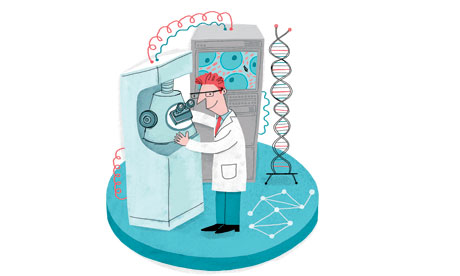 Nanotechnology is technology that operates on the nanoscale, about one billionth of a metre. If a living cell were a large city, then a nanometre would be about the size of a car. Nanotechnology is the art of engineering down at this hard-to-fathom scale.
Nanotechnology is technology that operates on the nanoscale, about one billionth of a metre. If a living cell were a large city, then a nanometre would be about the size of a car. Nanotechnology is the art of engineering down at this hard-to-fathom scale.The idea started in 1959 when famous physicist Richard Feynman suggested we could manipulate individual atoms and use them to build tiny machines. However, the term "nanotechnology" was not coined until the 1980s and lumps together different and varied ideas. All that unites these different technologies is that they use nano-sized building blocks. While other technologies make machines out of bulk materials – microchips out of silicon, wires out of copper, cars out of steel – nanotechnology makes machines out of large, complex molecules. Because nanotechnology works at such an extreme and unexplored scale, it opens up a world of new possibilities. Many nanomaterials possess special properties, such as great strength or high ability to conduct electricity.
Scientists working in the field of nanotechnology often look to nature to provide ideas for "smart" ways to solve complex problems. For example, spider silk and lotus leaves have both been studied in order to replicate their special properties, ie their tensile strength or ability to repel water, in engineered materials.
Why should I care about nanotechnology?
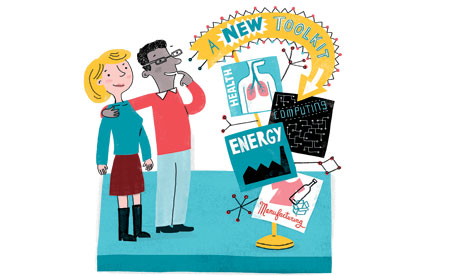 Nanotechnology is not just one technology, it is a whole new toolkit. It has the potential to change almost everything, from unimaginably small computer chips to tiny machines that find and fix damaged arteries inside our bodies. Nanotechnology could make our energy cleaner, our lives longer, and all of our existing technologies better.
Nanotechnology is not just one technology, it is a whole new toolkit. It has the potential to change almost everything, from unimaginably small computer chips to tiny machines that find and fix damaged arteries inside our bodies. Nanotechnology could make our energy cleaner, our lives longer, and all of our existing technologies better.This is not just a distant, science fiction-like dream – nanomaterials are already present in more than 1,000 consumer products, from cosmetics to cars. However, because nanotechnology works on such a new scale, it can be difficult to assess its dangers.
Everyday examples
Nanotechnology is a powerful tool for answering some of our most difficult questions. Scientists say we cannot afford to ignore the new medical, agricultural and environmental technologies it could provide as we search for solutions to an expanding global population.
Potential risks
Consumers will face different risks than the workers who manufacture these products, as they are the ones exposed to high doses. Various agencies are involved in making sure protection measures are adequate for both groups.
Where is nanotechnology used?
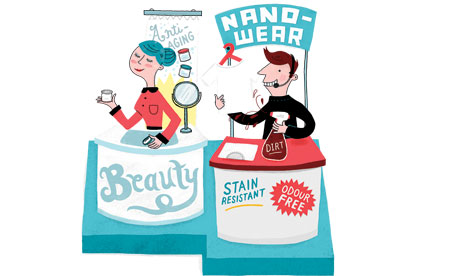 Nanotechnology is used in every sector you can think of, from the cars we drive to the clothes we wear. It is easy to see why ultra-lightweight materials with special electrical properties are useful, in electronics and computing for example, but nanomaterials are also present in scratch-resistant car bumpers, self-cleaning glass and anti-odour socks. Nanotech materials are being added to health and fitness products, from anti-ageing creams to skis. Silver is a powerful anti-microbial agent and more than 300 products use nanoscale silver to make anti-bacterial surfaces, clothing and even condoms.
Nanotechnology is used in every sector you can think of, from the cars we drive to the clothes we wear. It is easy to see why ultra-lightweight materials with special electrical properties are useful, in electronics and computing for example, but nanomaterials are also present in scratch-resistant car bumpers, self-cleaning glass and anti-odour socks. Nanotech materials are being added to health and fitness products, from anti-ageing creams to skis. Silver is a powerful anti-microbial agent and more than 300 products use nanoscale silver to make anti-bacterial surfaces, clothing and even condoms. Nanotechnology can also address environmental concerns. Nanotech catalytic converters and water filters remove environmental pollutants from our exhaust fumes and waste water. Wind turbines with nanomaterials are more efficient and cheaper, nanocrystal solar panels are just around the corner. Nanotechnology is already providing fresh solutions wherever it is applied.
Everyday example
The first use of nanomedicine was approved back in 1995 to treat cancer; since then researchers have continued to find new ways for nanotechnology to combat diseases.
Potential risks
Nanosilver, if over-used in consumer products that have a short lifespan, might cause harm to the environment.
How could it be used in the future?
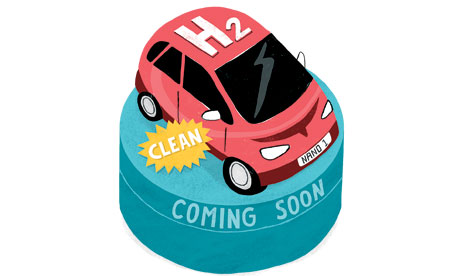 Today, many of our products are improved by nanomaterials. In the future, however, nanotechnology aims to use these nanomaterials to construct tiny nano-engineered machines, computers and medicines.
Today, many of our products are improved by nanomaterials. In the future, however, nanotechnology aims to use these nanomaterials to construct tiny nano-engineered machines, computers and medicines.In energy research, we may see a shift from using nanomaterials to improve existing technologies to using nanotechnology to develop entirely new ways of harnessing energy and, in the future, cars might be powered cleanly by hydrogen, stored safely in a solid form thanks to nanotechnology.
One day, nanotechnology may allow us to build any kind of structure we want from atomic building blocks to construct powerful computers, capable of processing as much information as a DNA molecule.
Everyday example
Researchers are already developing nanomedicines that target the proteins that accumulate in the brains of Alzheimer's patients, and nanoparticles that bind to tumour cells and treat them with antibodies. The big step will be using them to treat human diseases.
Potential risks
As with the adoption of all technologies, it is important to understand the motivation for doing so (eg money, public benefit) and its impacts, particularly risks.
Should nanoproducts be labelled?
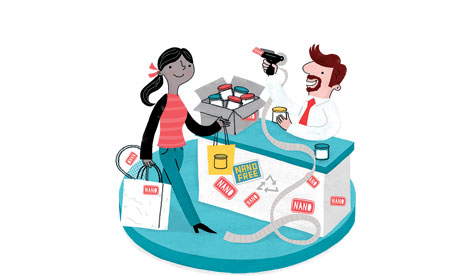 In November 2009, the European Union passed a law that will soon force manufacturers of cosmetics to state on the label if their products contain nanoparticles. Will more products follow? The issue of labelling has divided campaigners and politicians, just as it has with whether foods should be labelled as containing genetically modified ingredients.
In November 2009, the European Union passed a law that will soon force manufacturers of cosmetics to state on the label if their products contain nanoparticles. Will more products follow? The issue of labelling has divided campaigners and politicians, just as it has with whether foods should be labelled as containing genetically modified ingredients. Supporters of labels on nanotech say they will encourage consumer choice. Opponents say they will be meaningless without extra information on whether the nano-ingredients pose any risk. Without context, such labels could be misinterpreted as warnings, they say.
Everyday examples
Lipsticks and face creams that contain nanoparticles will soon be labelled as such. Perhaps "nano-free" could then start to appear on products too?
Potential risks
Labels might be a shortcut for industry to appear "transparent" without really informing the public.
Is the use of nanomaterials in food safe?
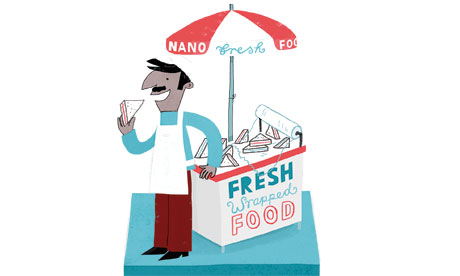 The food industry has been slow to exploit nanotechnology, perhaps because of public attitudes towards "non-natural" foods. But there are numerous ways the technology could be used, from stronger plastic films to keep sandwiches fresh for longer, to adding flavours to foods.
The food industry has been slow to exploit nanotechnology, perhaps because of public attitudes towards "non-natural" foods. But there are numerous ways the technology could be used, from stronger plastic films to keep sandwiches fresh for longer, to adding flavours to foods. In most cases, the development of such techniques has proceeded faster than the safety checks that are needed to make sure they are safe – could nanoparticles escape from plastic wrapping to enter a ham baguette? Would that packaging need to be disposed of differently and could it be recycled?
The European Food Standards Authority is keeping a close watch on developments.
Everyday examples
Nanoparticles could indicate the presence of harmful bacteria in foods.
Potential risks
The safety of nanomaterials used in food and food packaging must be fully assessed to avoid unwanted side effects.
What is the real added value of nanotech?
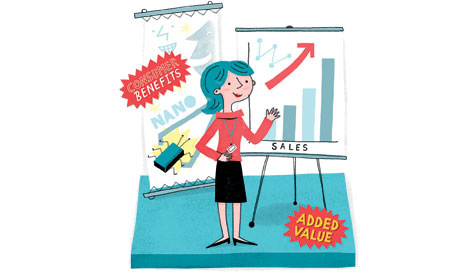 Nanotechnology is such a broad term that it is difficult to generalise about the value it could bring. There will be clear social value, in the form of cleaner energy and improved medicines; and individual value in that nanotechnology used in sporting equipment, for example, would improve an individual's performance. On the other hand, having hundreds of products that are anti-bacterial most likely will not bring many additional benefits to society.
Nanotechnology is such a broad term that it is difficult to generalise about the value it could bring. There will be clear social value, in the form of cleaner energy and improved medicines; and individual value in that nanotechnology used in sporting equipment, for example, would improve an individual's performance. On the other hand, having hundreds of products that are anti-bacterial most likely will not bring many additional benefits to society. Value, to a certain extent, is in the eye of the user of the technology. A patient who can benefit from one type of tiny particle injected into their bloodstream to test for heart disease and so avoid surgery, for example, would probably see more added value than an average tennis player who started playing with a racket made and improved by using nanomaterials. A mis-hit still goes into the net after all, nanotech racket or not.
Everyday examples
Nanotechnology is being used as a marketing tag to sell everything from socks and t-shirts to sports equipment. The true benefit comes from the way it is used by the consumer.
Do nanoproducts require special disposal?
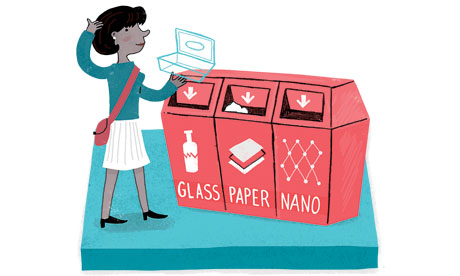 One of the concerns over the widespread use of nanotechnology is that tiny particles could escape from where they are intended to be used and end up polluting the wider environment.
One of the concerns over the widespread use of nanotechnology is that tiny particles could escape from where they are intended to be used and end up polluting the wider environment. This is not a problem confined to nanotechnology of course, and a number of chemicals that we know to be toxic are used in everyday products such as light bulbs and batteries. Consumers are asked to dispose of these products carefully, but there is no way to be sure that they will do so. And some escapes are impossible to prevent – for example, much of the mercury in the atmosphere comes from the cremation of dead people with dental fillings.
The effects of nanoparticles on the wider environment are largely unknown, so perhaps a cautious approach is the best one?
Everyday examples
Factories and research laboratories could release nanoparticles in their waste streams. Many international bodies are looking at ways in which accidental release of nanoparticles can be monitored and prevented.
Subscribe to:
Posts (Atom)

